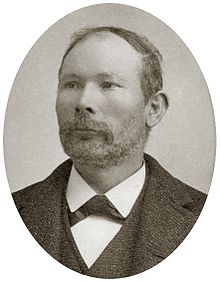| George Engel | |
|---|---|
 | |
| Born | (1836-04-15)April 15, 1836 Kassel, Electorate of Hesse |
| Died | November 11, 1887(1887-11-11) (aged 51) Cook County Jail, Chicago, Illinois, United States |
| Cause of death | Execution by hanging |
| Occupation | Toy store owner |
| Criminal status | Executed |
| Conviction(s) | Conspiracy to commit murder |
| Criminal penalty | Death |
George Engel (April 15, 1836 – November 11, 1887) was a labor union activist executed after the Haymarket riot, along with Albert Parsons, August Spies, and Adolph Fischer.
Early life
Engel was born to an impoverished family with three other children. His father, Konrad, a mason and bricklayer, died when he was one year old. His mother died when he was 12, leaving him an orphan. He lived for a short time with a foster family, but at the age of 14 was forced to look for work. He was apprenticed to a shoemaker, but was unable to afford the dues.
He travelled to Frankfurt and finally found work as a painter's apprentice. He travelled around Germany working, and in 1868 opened a business of his own. He married the same year, but found that the economic conditions in Germany made survival difficult, and so decided to follow his boyhood dream of emigrating to the United States. He left Germany in 1872, arriving first in Philadelphia, Pennsylvania, in January 1873, where he worked in a sugar refinery. In 1874, he left Philadelphia and moved to Chicago, Illinois, where he later, in 1876, opened his own toyshop.
Activism
Working at a factory, Engel first became acquainted with socialism when one of his coworkers took him to a meeting of the International Workingmen's Association. He soon joined. In 1878, a crackdown on socialist organizations led to the dissolution of the IWA, but Engel was instrumental in forming another organization, the Socialistic Labor Party of North America, and finally, in 1882 he joined the new International Working People's Association.
Haymarket Square
On May 3, 1886, after hearing about the massacre at the McCormick Plant earlier that day, he attended a meeting at Grief's Hall. This meeting, later dubbed by prosecutors the "Monday Night Conspiracy", was used to prove that there was a conspiracy in the bombing at the Haymarket. A witness claimed that Engel had arranged a plan to storm and/or dynamite police stations and shoot policemen should trouble occur. Engel claims it was a meeting only "in which it was proposed to give aid to any strikers if the police or the Pinkertons should attack said strikers."
The following night, May 4, as the bombing took place, Engel was not in Haymarket Square, but was at home playing cards. Nevertheless, he was arrested the next day and charged with conspiracy in the bombings. At 50, he was the oldest of the defendants to stand trial. He was convicted and was sentenced to be hanged. After hearing in 1887 that several letters had been written from Samuel Fielden and Michael Schwab to Illinois Governor Richard James Oglesby, Engel wrote his own letter asking the governor not to consider any clemency, stating that: "not being conscious of any guilt, the powers that be may murder me, but they cannot legally punish me. I protest against a commutation of my sentence and demand either liberty or death."
Death
Engel was hanged with three others of the condemned on November 11, 1887. His last words were "Hurrah for anarchy!" His execution during the Haymarket affair helped result in the date chosen for International Workers' Day.
Engel was buried, in a plot marked since 1893 by the Haymarket Martyrs Monument, in the Waldheim Cemetery (now Forest Home Cemetery) in Forest Park, Illinois.
See also
References
- HADC - Testimony of Godfried Waller (first appearance), 1886 July 16
- Meet the Haymarket Defendants
- HADC - George Engel letter to Governor Richard Oglesby, 1887 Nov. 9
- Avrich, Paul (1984). The Haymarket Tragedy. Princeton: Princeton University Press. p. 393. ISBN 978-0-691-00600-0.
- Nathan Fine, Labor and Farmer Parties in the United States, 1828–1928. New York: Rand School of Social Science, 1928; p. 53.
- The Americas
Further reading
- Engel, George (1969). "Autobiography of George Engel". In Foner, Philip S. (ed.). The Autobiographies of the Haymarket Martyrs. New York: Humanities Press. pp. 93–98. ISBN 0-913460-58-3.
- The Accused the Accusers: The Famous Speeches of the Chicago Anarchists in Court: On October 7th, 8th, and 9th, 1886, Chicago, Illinois. Chicago: Socialistic Publishing Society, n.d. .
- Meet the Haymarket Defendants
- David, Henry. The History of the Haymarket Affair. New York: Collier Books, 1963.
| Haymarket affair | ||
|---|---|---|
| Defendants | ||
| Trial |
| |
| Related | ||
- 1836 births
- 1887 deaths
- People from Kassel
- People from the Electorate of Hesse
- Emigrants from the German Empire to the United States
- Members of the International Workingmen's Association
- Activists from Chicago
- Haymarket affair
- American people executed for murdering police officers
- German people convicted of murdering police officers
- People convicted of murder by Illinois
- Executed people from Hesse
- 19th-century executions by the United States
- People executed by Illinois by hanging
- German people executed abroad
- 19th-century executions of American people
- Burials at Forest Home Cemetery, Chicago
- 1886 murders in the United States
- Executed trade unionists